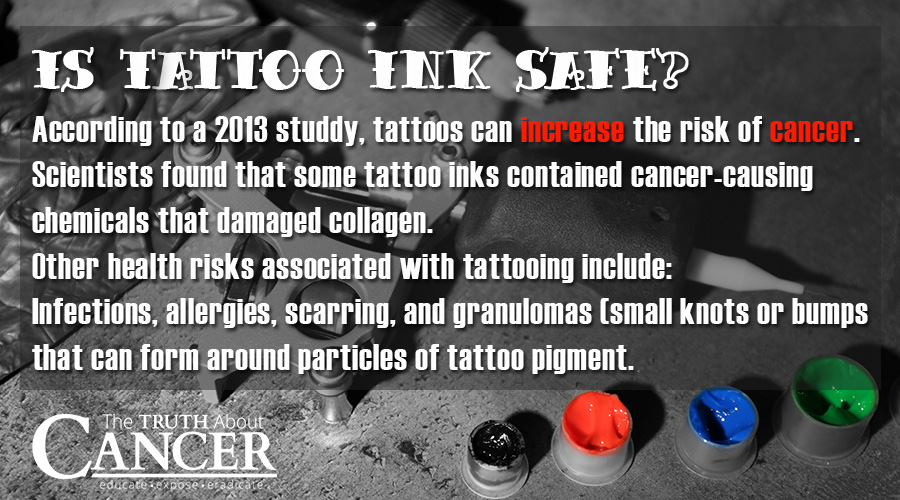By Suresh Nair

For most people nowadays, getting inked is an acceptable, relatively mainstream activity. According to a Harris poll, roughly one in four to five American adults can now boast of having at least one tattoo.
Tattoos have been around for thousands of years. For instance, they were used to identify peasants and slaves in ancient Egypt. In the warlike tribes of Samoa and other Pacific Islands, extensive tattooing was proudly exhibited as a display of courage, endurance, and dedication to cultural traditions. In Japan, tattooing for spiritual and decorative purposes is believed to date as far back as 10,000 BC. In modern-day Japan, tattoos have long been associated with the yakuza, Japan’s notorious criminal underworld.
With the immense popularity of tattoos, perhaps now is a good time to consider the possible health effects tattoos have on your body, along with being a decorative form of self-expression.
Do Tattoos Have An Effect on Health?
Permanent tattoos are made by using needles to inject colored inks below the skin’s surface. While the actual practice of tattooing is regulated by state and local authorities, tattoo inks are subject to FDA regulation as cosmetics and color additives.
However, because of a previous lack of evidence of safety concerns, the FDA has traditionally
refrained from regulating tattoo inks or the pigments used in them. It is only relatively recently in response to reports of adverse reactions associated with tattoo and other permanent make-up inks that the FDA has been moved to belatedly examine the issue of tattoo ink safety.
Health risks associated with tattooing include infections, allergies, scarring, granulomas (small knots or bumps that can form around particles of tattoo pigment), and MRI complications such as swelling or burning when people with tattoos undergo an MRI.
The FDA’s National Center for Toxicological Research (NCTR) has begun to investigate tattoo inks to identify their chemical composition and how they break down in the body. Additionally, they’re also looking at the short-term and long-term safety of tattoo inks and how the body responds to light interacting with the inks.
For instance, research has shown that some pigment migrates from the tattoo site to the body’s lymph nodes, which are part of the lymphatic system – a collection of fluid-carrying vessels that drains into the blood and whose job it is to filter out disease-causing organisms. Whether the presence of tattoo ink in the lymphatic system has adverse health consequences or not is still unknown.
Tattoos and Skin Health
According to a 2015 study, roughly 10% of people who get tattoos develop infections, itching, and other adverse reactions on their skin, which can sometimes last more than four months.
Researchers at New York University asked 300 people in Central Park whether they had a tattoo – and if so, whether they had experienced any adverse skin reactions after getting inked. Of those surveyed, 31 said they had developed abnormal reactions, including pain, itching, and skin infections. It’s not clear if these numbers are representative of the entire inked population.
In 4 out of the 10% who reported adverse reactions, the health complaints disappeared in less than four months. Unfortunately, some of these people needed treatment. The remaining 6% had itching, scaly skin, and swelling around the tattoo site that lasted for more than four months.
The study researchers suspected that allergic reactions to the dyes used in tattoo parlors – especially red-colored dyes – may be responsible for these chronic, long-lasting reactions. Other small studies have also reported skin problems associated with red dyes.
According to the Mayo Clinic in the U.S., tattoo ink can cause allergic reactions and skin infections – not to mention dangerous blood-borne diseases such as tetanus, hepatitis B, and hepatitis C.
Some of these potential health problems can easily be avoided by cleaning the tattoo site thoroughly to reduce infection risk. Also, tattooing as a practice is a lot safer now that tattoo parlors are regularly monitored to ensure that they use safe practices and equipment such as single-use needles.
However, one potentially serious health hazard remains…
There are no federal regulations on tattoo ink. And as we have already seen, the FDA has only recently begun to investigate the health consequences of tattoo inks for our body.
As you read on, you’ll realize that the composition of dyes used for tattooing is an important issue that needs to be properly understood and carefully assessed − especially with regards to cancer risk.
Benzo(a)pyrene and Other Cancer-Inducing Components in Tattoo Ink
Health concerns about the presence of toxic chemicals in tattoos first emerged in 2011 when studies showed that benzo(a)pyrene, a chemical used in black tattoo ink, could induce skin cancer in test animals.
In fact, benzo(a)pyrene – found originally in coal tar – is listed as a carcinogen by the International Agency for Research on Cancer (IARC).
Further, a study carried out at Copenhagen University Hospital found cancer-causing chemicals in 13 out of 21 commonly used European tattoo inks. The Danish researcher leading this study went on record to say that the millions of Europeans being tattooed using chemical substances of unknown origin should be given detailed information about the inks being used on them, along with the effects on their health.
The Tattoo Ink Manufacturers of Europe (TIME) states that up to 5% of tattoo studios use inks containing carcinogenic aromatic amines. They strongly advocate reducing the presence of these carcinogenic components in tattoo inks to zero.
Nanoparticles Found in Tattoo Ink
A study published in the British Journal of Dermatology in 2011 was the first to reveal the presence of so-called “nanoparticles” in tattoo inks. Using sophisticated methods such as laser diffraction, electron microscopy, and X-ray diffraction, this study showed that black pigments contain the smallest particles, while white pigments had the largest particles, and colored pigments had intermediate-sized particles.
Notably, the vast majority of tested tattoo inks contained significant amounts of nanoparticles except for the white pigments. In fact, the black pigments were almost pure nanoparticles – which are defined as particles with at least one dimension less than 100 nanometers.
A nanometer is an unimaginably small unit of spatial measurement, equal to one billionth of a meter. It is a term commonly used in nanotechnology, which is the science behind the building of extremely small machines.
Most black tattoo inks are made up of soot products such as carbon black and may also contain small amounts of polycyclic aromatic hydrocarbons (PAHs). PAHs are considered pollutants due to their potential for causing adverse health effects and have been strongly linked to skin, lung, bladder, liver, and stomach cancers in various studies using animal models.
Cancer and the Role of Nanoparticles
According to a 2013 study carried out at Bradford University in the U.K., tattoos can increase the risk of cancer.
Bradford University scientists found that tattoo inks contained cancer-causing chemicals that damaged collagen, which is a major protein that forms roughly 30% of the protein content of the human body. In fact collagen is the foundation of so-called “connective tissue” that holds us together. Collagen also contributes to the skin’s elasticity and youthfulness.
This study showed that nanoparticles from tattoo dyes migrated, or moved away from the skin, to enter the blood and eventually build up in the spleen and kidneys. (We’ll talk about what exactly nanoparticles are and what they can mean for your health a little further on). Both the spleen and kidneys are fragile organs, sensitive to injury and crucial for cleansing the body by getting rid of impurities.
According to one of the head researchers from Bradford University’s Centre for Skin Sciences, where this study was carried out:
“…There is no question that these substances can be toxic. It takes a long time for the multiple-step nature of cancer to show its face. I don’t think we should wait 20 years to see if there is anything wrong with these ingredients.”
The Potential Dangers of Nanoparticles
There’s no two ways about it – nanoparticles represent an incredible advance in technology. For instance, nanotechnology reduces the size of vitamins down to microscopic nano-droplets that are much easier for your body to absorb, potentially providing greater health benefits.
On the other hand, is it possible that by reducing a particle’s size it becomes capable of evading the body’s natural defenses more easily?
Could nanoparticles enter pores in the skin faster – and bypass our immune and detoxification mechanisms that have evolved millions of years before the nanotechnology came into existence?
Concerns such as these are why some health experts caution that great care needs to be taken as to what particles are being produced on the nano-scale. It may be that by artificially designing substances to be significantly smaller in size than would occur naturally, they may become more toxic to the body than they would otherwise be.
Carbon Black in Tattoo Ink is Potentially Carcinogenic
Carbon black is a particulate form of elemental carbon that is mainly used in rubber products, mainly tires. It is also used as a pigment in inks (including black tattoo inks), paints, and coatings, as well as in plastics. Exposure to carbon black particles occurs mainly in the form of aggregates during its manufacturing process.
Workers who produced carbon black in Germany and the U.K. had an excess risk of lung cancer, although no clear relationship between exposure to carbon black and lung cancer was found. However, another study of workers in the rubber industry in Germany exposed to carbon black showed no significant excess risk of lung cancer.
Carbon black and its extracts have also been tested in laboratory animals. These tests provided sufficient evidence for the carcinogenicity of carbon black and carbon black extracts. Based on these data, the working group of the International Agency for Research on Cancer (IARC) has classified carbon black as possibly carcinogenic to human beings.
Based on these worrying findings, The Friends of the Earth – a global network of grassroots groups – is now calling for proper regulation of tattoo inks.
Black Tattoo Inks Induce Harmful “Reactive Oxygen Species”
A 2013 study examined the effects of a total of nine brands of tattoo inks of six colors each (black, red, yellow, blue, green, and white), along with two additional black inks of different brands, on formation of harmful reactive oxygen species (ROS).
ROS is the name for chemically reactive molecules containing oxygen. Biologically speaking, ROS are formed naturally and play an important role in the normal functioning of the body’s cells.
However, ROS generated by exposure to UV rays, radiation, and toxins like carbon black in black tattoo inks can potentially severely damage structures inside cells, leading to observable clinical symptoms including damage to the skin.
Interestingly, the study researchers found that two black inks produced the highest amounts of ROS. Not only that, the same two inks aggregated much more strongly in water relative to the other inks.
Further, ten of the11 black inks had levels of polycyclic aromatic hydrocarbons (PAHs) exceeding the European Council’s recommended level – and all 11 exceeded the recommended level for benzo(a)pyrene – which as we saw earlier, has been classified as a carcinogen by the International Agency for Research on Cancer (IARC).
Some scientists also believe that PAHs may stay in the skin, absorb UV radiation from the sun and generate so-called “singlet oxygen” inside the dermis of the skin, damaging skin integrity.
Singlet oxygen is a high energy form of oxygen that is highly reactive – and possibly damaging – to organic matter, including the skin and other cells in the body.
Is Getting a Tattoo Worth the Risk?
Tattoos have been around for thousands of years. Given that it’s an acceptable form of self-expression today, it’s important to carefully consider the possible health effects tattoo ink can have on your body.
Unfortunately, there are many health risks associated with tattooing. Specifically, the composition of tattoo dyes needs to be carefully examined with regards to cancer risk.
Studies have shown that benzo(a)pyrene, a chemical in black tattoo ink, can induce skin cancer in test animals, while other cancer-causing chemicals have also been identified in many other tattoo inks. For instance, the International Agency for Research on Cancer (IARC) has classified carbon black – a major component of black tattoo ink – as possibly carcinogenic to human beings.
Additionally, black inks appear to be capable of producing reactive oxygen species (ROS) which can potentially damage skin cells.
It’s worth remembering that the vast majority of tested tattoo inks contain nanoparticles, which may be capable of evading the body’s natural defenses more easily. In fact, black tattoo pigments are almost pure nanoparticles, which have been shown to migrate away from the skin, damage collagen, and accumulate in the spleen and kidneys, with possibly harmful effects for health.
Please help bring more awareness about the link between tattoo ink and cancer by sharing this article with your friends and family below.
Article Summary
With the immense popularity of tattooing, it’s time to consider the possible health effects tattoos have on your body − especially any increased risks for cancer.
Known health risks associated with tattooing include infections, allergies, scarring, granulomas (small knots or bumps that can form around particles of tattoo pigment), and MRI complications such as swelling or burning when people with tattoos undergo an MRI.
There are no federal regulations on tattoo ink. Recently the FDA’s National Center for Toxicological Research (NCTR) has begun to investigate the chemical composition of tattoo inks and how they break down in the body. They’re also looking at the short and long-term safety of tattoo inks and how the body responds to light interacting with the inks.
Studies have shown that benzo(a)pyrene, a chemical in black tattoo ink, can induce skin cancer in test animals, while other cancer-causing chemicals have also been identified in many other tattoo inks. The International Agency for Research on Cancer (IARC) has classified carbon black – a major component of black tattoo ink – as possibly carcinogenic to human beings.
According to a 2013 study carried out at Bradford University in the U.K., tattoos can increase the risk of cancer. Scientists found that tattoo inks contained cancer-causing chemicals that damaged collagen.
The vast majority of tested tattoo inks contain nanoparticles, which may be capable of evading the body’s natural defenses more easily. In fact, black tattoo pigments are almost pure nanoparticles, which have been shown to migrate away from the skin, damage collagen, and accumulate in the spleen and kidneys, with possibly harmful effects for health.


No hay comentarios:
Publicar un comentario